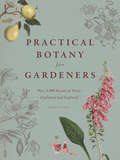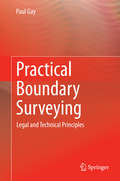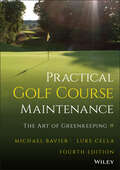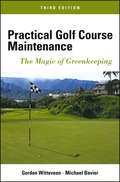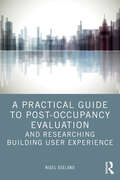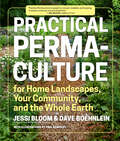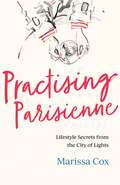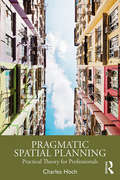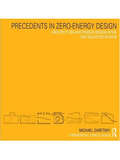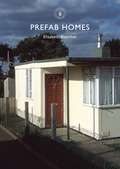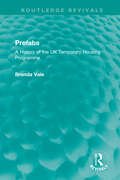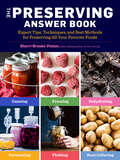- Table View
- List View
The Power of Existing Buildings: Save Money, Improve Health, and Reduce Environmental Impacts
by Robert Sroufe Craig E. Stevenson Beth EckenrodeIn The Power of Existing Buildings, academic sustainability expert Robert Sroufe, and construction and building experts Craig Stevenson and Beth Eckenrode, explain how to realize the potential of existing buildings and make them perform like new. This step‑by‑step guide will help readers to: understand where to start a project; develop financial models and realize costs savings; assemble an expert team; and align goals with numerous sustainability programs. The Power of Existing Buildings will challenge you to rethink spaces where people work and play, while determining how existing buildings can save the world. The insights and practical experience of Sroufe, Stevenson, and Eckenrode, along with the project case study examples, provide new insights on investing in existing buildings for building owners, engineers, occupants, architects, and real estate and construction professionals.
The Power of Objects in Eighteenth-Century British America (Published by the Omohundro Institute of Early American History and Culture and the University of North Carolina Press)
by Jennifer Van HornOver the course of the eighteenth century, Anglo-Americans purchased an unprecedented number and array of goods. The Power of Objects in Eighteenth-Century British America investigates these diverse artifacts—from portraits and city views to gravestones, dressing furniture, and prosthetic devices—to explore how elite American consumers assembled objects to form a new civil society on the margins of the British Empire. In this interdisciplinary transatlantic study, artifacts emerge as key players in the formation of Anglo-American communities and eventually of American citizenship. Deftly interweaving analysis of images with furniture, architecture, clothing, and literary works, Van Horn reconstructs the networks of goods that bound together consumers in Boston, New York, Philadelphia, and Charleston.Moving beyond emulation and the desire for social status as the primary motivators for consumption, Van Horn shows that Anglo-Americans' material choices were intimately bound up with their efforts to distance themselves from Native Americans and African Americans. She also traces women's contested place in forging provincial culture. As encountered through a woman's application of makeup at her dressing table or an amputee's donning of a wooden leg after the Revolutionary War, material artifacts were far from passive markers of rank or political identification. They made Anglo-American society.
Practical Botany for Gardeners: Over 3,000 Botanical Terms Explained and Explored
by Geoff HodgeGardening can be frustratingly shrouded in secrecy. Fickle plants make seemingly spontaneous decisions to bloom or bust, seeds sprout magically in the blink of an eye, and deep-rooted mysteries unfold underground and out of sight. Understanding basic botany is like unlocking a horticultural code; fortunately learning a little science can reveal the secrets of the botanical universe and shed some light on what’s really going on in your garden. Practical Botany for Gardeners provides an elegant and accessible introduction to the world of botany. It presents the essentials that every gardener needs to know, connecting explanations of scientific facts with useful gardening tips. Flip to the roots section and you’ll not only learn how different types of roots support a plant but also find that adding fungi to soil aids growth. The pruning section both defines “lateral buds” and explains how far back on a shoot to cut in order to propagate them. The book breaks down key areas and terminology with easy-to-navigate chapters arranged by theme, such as plant types, plant parts, inner workings, and external factors. “Great Botanists” and “Botany in Action” boxes delve deeper into the fascinating byways of plant science. This multifaceted book also includes two hundred botanical illustrations and basic diagrams that hearken to the classic roots of botany. Part handbook, part reference, Practical Botany for Gardeners is a beautifully captivating read. It’s a must for garden lovers and backyard botanists who want to grow and nurture their own plant knowledge.
Practical Botany for Gardeners: Over 3,000 Botanical Terms Explained and Explored
by Geoff HodgeGardening can be frustratingly shrouded in secrecy. Fickle plants make seemingly spontaneous decisions to bloom or bust, seeds sprout magically in the blink of an eye, and deep-rooted mysteries unfold underground and out of sight. Understanding basic botany is like unlocking a horticultural code; fortunately learning a little science can reveal the secrets of the botanical universe and shed some light on what’s really going on in your garden. Practical Botany for Gardeners provides an elegant and accessible introduction to the world of botany. It presents the essentials that every gardener needs to know, connecting explanations of scientific facts with useful gardening tips. Flip to the roots section and you’ll not only learn how different types of roots support a plant but also find that adding fungi to soil aids growth. The pruning section both defines “lateral buds” and explains how far back on a shoot to cut in order to propagate them. The book breaks down key areas and terminology with easy-to-navigate chapters arranged by theme, such as plant types, plant parts, inner workings, and external factors. “Great Botanists” and “Botany in Action” boxes delve deeper into the fascinating byways of plant science. This multifaceted book also includes two hundred botanical illustrations and basic diagrams that hearken to the classic roots of botany. Part handbook, part reference, Practical Botany for Gardeners is a beautifully captivating read. It’s a must for garden lovers and backyard botanists who want to grow and nurture their own plant knowledge.
Practical Boundary Surveying: Legal and Technical Principles
by Paul GayThis complete guide to boundary surveying provides landowners, land surveyors and students with the necessary foundation to understand boundary surveying techniques and the common legal issues that govern boundary establishment. Far from a simple engineering function, boundary establishment is often a difficult and delicate matter, with real monetary and legal ramifications if not accomplished accurately. This book helps readers to understand why such challenges exist and what remedies may be available. Using only simple and logically explained mathematics, the principles and practice of boundary surveying are demystified for those without prior experience and the focused coverage of pivotal issues such as easements and setting lot corners will aid even licensed practitioners in untangling thorny cases. Practical advice on using both basic and advanced instruments is included, alongside clear explanations of legal regulations that will impact any surveyor’s work. For those who desire a more in-depth treatment of the mathematical aspects of boundary surveying, the Appendix includes the underlying theory and many examples of typical calculations performed by boundary surveyors.
Practical Ethics in Architecture and Interior Design Practice
by Sue Lani Madsen Dana E. Vaux David WangPractical Ethics in Architecture and Interior Design Practice presents the basics of design practice through ethical scenarios, ushering design students into real-world experiential learning. Each chapter begins with a detailed story involving a complicated set of practical and ethical dilemmas, exemplifying those encountered each day in the world of professional practice. Practice-based topics such as contracts and project delivery methods, marketing design services, cross-cultural collaboration, virtual connectivity, social justice and sustainable design, soft skills, and other related professional practice themes are anchored in realistic scenarios. While all the stories are fictional, in writing them the authors drew from over seventy-five combined years of professional experience in architecture and interior design as well as many years of academic experience in teaching professional practice and ethics to architecture and interior design students. Each story is followed by discussion questions and suggested additional resources. This book provides a unique integrated perspective into the allied fields of architecture and interior design with topics relevant to both fields as well as specific to each profession. It prepares students of both disciplines for the broad issues of professional practice and encourages them to become ethical practitioners ready to contribute effectively to design teams and to ask the right questions.
Practical Ethics in Architecture and Interior Design Practice
by Sue Lani Madsen Dana E. Vaux David WangPractical Ethics in Architecture and Interior Design Practice presents the basics of design practice through ethical scenarios, ushering design students into real-world experiential learning. Each chapter begins with a detailed story involving a complicated set of practical and ethical dilemmas, exemplifying those encountered each day in the world of professional practice. Practice-based topics such as contracts and project delivery methods, marketing design services, cross-cultural collaboration, virtual connectivity, social justice and sustainable design, soft skills, and other related professional practice themes are anchored in realistic scenarios. While all the stories are fictional, in writing them the authors drew from over seventy-five combined years of professional experience in architecture and interior design as well as many years of academic experience in teaching professional practice and ethics to architecture and interior design students. Each story is followed by discussion questions and suggested additional resources. This book provides a unique integrated perspective into the allied fields of architecture and interior design with topics relevant to both fields as well as specific to each profession. It prepares students of both disciplines for the broad issues of professional practice and encourages them to become ethical practitioners ready to contribute effectively to design teams and to ask the right questions.
Practical Golf Course Maintenance: The Art of Greenkeeping
by Michael Bavier Luke CellaA Practical Step-by-Step Guide to Maintaining and Operating a Golf Course From the fairway to the flagsticks, operating a golf course presents a variety of challenges. To maintain a beautiful course and ensure smooth day-to-day operations, one must possess a strong foundation of knowledge across many different fields. Practical Golf Course Maintenance, Fourth Edition assists golf industry professionals with every component of course management so that players have the best experience possible. As seasoned golf industry professionals, the two authors have years of hands-on experience in the field solving problems relating to every facet of running a modern golf course. This fourth edition contains new and updated advice and guidelines for running a golf course, including: A new chapter offering guidance for superintendents to work with club officials and green committee members to achieve success in their challenging roles Rule changes from the USGA and R&A and how they affect maintenance strategies Discussions of current and future course technologies, including robotic mowers, drones, and advanced irrigation systems An overview of the evolving job descriptions and responsibilities of key positions in the field A common sense approach to the art of greenkeepingPractical Golf Course Maintenance, Fourth Edition has been purposefully written to provide useful information to both the untrained and experienced greenkeeping professional. It serves as a thorough introduction of golf course maintenance to anyone interested in the profession, including course or club officials and managers, green committee members, and anyone who has a vested interest in understanding what it takes to run a golf course.
Practical Golf Course Maintenance: The Art of Greenkeeping
by Michael Bavier Luke CellaA Practical Step-by-Step Guide to Maintaining and Operating a Golf Course From the fairway to the flagsticks, operating a golf course presents a variety of challenges. To maintain a beautiful course and ensure smooth day-to-day operations, one must possess a strong foundation of knowledge across many different fields. Practical Golf Course Maintenance, Fourth Edition assists golf industry professionals with every component of course management so that players have the best experience possible. As seasoned golf industry professionals, the two authors have years of hands-on experience in the field solving problems relating to every facet of running a modern golf course. This fourth edition contains new and updated advice and guidelines for running a golf course, including: A new chapter offering guidance for superintendents to work with club officials and green committee members to achieve success in their challenging roles Rule changes from the USGA and R&A and how they affect maintenance strategies Discussions of current and future course technologies, including robotic mowers, drones, and advanced irrigation systems An overview of the evolving job descriptions and responsibilities of key positions in the field A common sense approach to the art of greenkeepingPractical Golf Course Maintenance, Fourth Edition has been purposefully written to provide useful information to both the untrained and experienced greenkeeping professional. It serves as a thorough introduction of golf course maintenance to anyone interested in the profession, including course or club officials and managers, green committee members, and anyone who has a vested interest in understanding what it takes to run a golf course.
Practical Golf Course Maintenance: The Magic of Greenkeeping
by Gordon Witteveen Michael BavierThe revised, bestselling resource of practical, nontechnical advice for maintaining and operating a golf course Practical Golf Course Maintenance, Third Edition presents the latest information and techniques for providing first-rate upkeep and management operations for any golf course. This book's, clear, step-by-step coverage, unencumbered by technical language, includes critical advice on maintaining consistent bunkers, sand top-dressing and aerifying, pesticide storage, and other emerging technologies, as well as mowing techniques for greens, fairways, and tees—and much more! This updated Third Edition offers reliable, state-of-the-art guidance and hundreds of helpful tips with: Major revisions throughout to address the latest information on computer- operated irrigation systems, new equipment for all aspects of course maintenance, water quality and conservation issues, and managing people A clear approach that avoids technical language and scientific citations while delivering practical advice that can be immediately applied on the course Coverage of all aspects of course maintenance from tee to green, along with guidance on managing the course for the rules of the game and managing the business aspects of course management and maintenance Practical Golf Course Maintenance, Third Edition is a valuable tool for golf course owners, architects, builders, golfers, golf professionals, club managers, and superintendents, as well as greens committee members, irrigation specialists, field managers, turfgrass specialists, real estate developers, and landscape architects.
Practical Golf Course Maintenance: The Magic of Greenkeeping
by Gordon Witteveen Michael BavierThe revised, bestselling resource of practical, nontechnical advice for maintaining and operating a golf course Practical Golf Course Maintenance, Third Edition presents the latest information and techniques for providing first-rate upkeep and management operations for any golf course. This book's, clear, step-by-step coverage, unencumbered by technical language, includes critical advice on maintaining consistent bunkers, sand top-dressing and aerifying, pesticide storage, and other emerging technologies, as well as mowing techniques for greens, fairways, and tees—and much more! This updated Third Edition offers reliable, state-of-the-art guidance and hundreds of helpful tips with: Major revisions throughout to address the latest information on computer- operated irrigation systems, new equipment for all aspects of course maintenance, water quality and conservation issues, and managing people A clear approach that avoids technical language and scientific citations while delivering practical advice that can be immediately applied on the course Coverage of all aspects of course maintenance from tee to green, along with guidance on managing the course for the rules of the game and managing the business aspects of course management and maintenance Practical Golf Course Maintenance, Third Edition is a valuable tool for golf course owners, architects, builders, golfers, golf professionals, club managers, and superintendents, as well as greens committee members, irrigation specialists, field managers, turfgrass specialists, real estate developers, and landscape architects.
A Practical Guide to Post-Occupancy Evaluation and Researching Building User Experience
by Nigel OselandA Practical Guide to Post-Occupancy Evaluation offers high-level pragmatic guidance and case study examples on how to conduct a Post-Occupancy Evaluation (POE) to determine whether a workplace project is successful and uncover the lessons learned for future projects. For designers, POEs provide essential predesign feedback, informing the design brief to determine occupant requirements and help focus expenditure. For those in charge of a building or buildings, POE offers proactive building management and can also be used as part of the change management programme in larger projects, informing the occupants of progress. The practical guidance offered in this book will help the workplace industry understand if a design meets the requirements of an occupier and measure the success of and value offered by a workplace project.This book will be of interest to professionals in the workplace industry responsible for delivering and evaluating capital projects as well as those studying interior design, architecture, surveying, facilities management and building services engineering.
A Practical Guide to Post-Occupancy Evaluation and Researching Building User Experience
by Nigel OselandA Practical Guide to Post-Occupancy Evaluation offers high-level pragmatic guidance and case study examples on how to conduct a Post-Occupancy Evaluation (POE) to determine whether a workplace project is successful and uncover the lessons learned for future projects. For designers, POEs provide essential predesign feedback, informing the design brief to determine occupant requirements and help focus expenditure. For those in charge of a building or buildings, POE offers proactive building management and can also be used as part of the change management programme in larger projects, informing the occupants of progress. The practical guidance offered in this book will help the workplace industry understand if a design meets the requirements of an occupier and measure the success of and value offered by a workplace project.This book will be of interest to professionals in the workplace industry responsible for delivering and evaluating capital projects as well as those studying interior design, architecture, surveying, facilities management and building services engineering.
Practical Management of Invasive Non-Native Weeds in Britain and Ireland
by Mark Fennell Laura Jones Max WadeAdvice involves immediate 'rapid-response' actions to initiate containment along with preventative strategies, measures for control and monitoring requirements post-control. The manual responds to the GB Non-Native Species Strategy and deals with over 40 species which have been selected from plants listed in Schedule 9 of the Wildlife & Countryside Act 1981 (as amended) for the UK; invasive alien species of EU concern (as per EU IAS Regulation 1143/2014); and other noteworthy species of the urban environment, for example butterfly-bush (buddleia). Each species account includes: a brief description on ecology and identification with corresponding photographs; a distribution map for the British and Irish Isles; immediate actions that can be taken once identified; pathways of spread; lifespan; seed-production age; seed longevity; growth rate; a 'schematic' of the life-cycle aimed at assisting the determination of schedules for survey and treatment; prevention and rapid-response measures; tables of control, management and herbicide treatment linked to decision-making flow diagrams; waste-disposal requirements; revegetation post-management; and continued monitoring. Key references to published data and links to appropriate websites are also included.
Practical Permaculture: for Home Landscapes, Your Community, and the Whole Earth
by Jessi Bloom Dave BoehnleinCan you imagine a world in which your thriving garden nourishes all of your needs? The first step to building a sustainable ecosystem starts with Practical Permaculture.
Practising Parisienne: Lifestyle Secrets from the City of Lights
by Marissa Cox'Even if you don't find yourself booking a one-way Eurostar ticket to the capital like Marissa, this book might just be the key to finally nailing that elusive Parisian je ne sais quoi.' Penny Goldstone, Fashion Editor, Marie Claire'A delightful, down-to-earth guide . . . complete with insider fashion tips, beauty tricks and dating advice from Marissa's own personal experience, plus interviews with many modern iterations of the ever-elusive Parisienne herself.' Monica de La Villardière, journalist and co-founder of the Fashion No Filter podcastTo be Parisian is to have a certain attitude and outlook on life. In Practicing Parisienne, British journalist and blogger Marissa Cox decodes this seemingly nebulous je ne sais quoi, explaining what she has learned since moving to France eight years ago, and how and why the reader can and should adopt a more Parisian lifestyle. She reveals how she learnt to live her best life in this iconic city, what it means to be Parisian and in turn inspire you to make positive changes in your own lives, however big or small. Covering everything from style, fashion, beauty and wellbeing to chic interiors and food and wine, as well as advice about dating and friendship, each section also contains interviews with well-known Parisians and Francophiles who inspire us to live better. Because, as we know, Paris is ALWAYS a good idea.'Practising Parisienne is a celebration of the City of Lights and an ode to the pleasures in life. Marissa Cox effortlessly mixes practical tips, personal stories and inspiring conversations in this charming guide to living well the Parisian way.' Miranda York, author of At the Table and The Food Almanac 'With appreciation, honesty, a deep understanding and access to leading figures, Practising Parisienne reads like a who's who and what's what when it comes to everything Parisian.' Hannah Almassi, Editor in Chief, Who What Wear UK
Pragmatic Spatial Planning: Practial Theory for Professionals
by Charles HochInstead of seeking theory to justify practical professional judgments this book describes how professionals can and should use theory to guide these judgments. Professional spatial planning in the US, and globally, continues to suffer from a weak conceptual grasp of its own practice. Practitioners routinely recognize the value and wisdom of practical judgment finely attuned to context, nuance and complexity; but later offer banal testimony and glib stories of ‘just so’ best-practice discrediting the ambiguity of their own experience. The chapters in this book provide a vocabulary tailored to the conventions of practical judgment, challenging students and practitioners to treat professional expertise as work in progress rather than ‘best’ practice. Instead of seeking theory to justify practical professional judgments, Hoch describes how professionals can and should use theory to guide these judgments. The pragmatist plan helps cope with complexity rather than control it, making it invaluable in the anyone’s pursuit of a planning career. This book will appeal to a wide cross section of students and scholars, especially those working in urban planning, public policy, and government.
Pragmatic Spatial Planning: Practial Theory for Professionals
by Charles HochInstead of seeking theory to justify practical professional judgments this book describes how professionals can and should use theory to guide these judgments. Professional spatial planning in the US, and globally, continues to suffer from a weak conceptual grasp of its own practice. Practitioners routinely recognize the value and wisdom of practical judgment finely attuned to context, nuance and complexity; but later offer banal testimony and glib stories of ‘just so’ best-practice discrediting the ambiguity of their own experience. The chapters in this book provide a vocabulary tailored to the conventions of practical judgment, challenging students and practitioners to treat professional expertise as work in progress rather than ‘best’ practice. Instead of seeking theory to justify practical professional judgments, Hoch describes how professionals can and should use theory to guide these judgments. The pragmatist plan helps cope with complexity rather than control it, making it invaluable in the anyone’s pursuit of a planning career. This book will appeal to a wide cross section of students and scholars, especially those working in urban planning, public policy, and government.
Precedents in Zero-Energy Design: Architecture and Passive Design in the 2007 Solar Decathlon
by Michael Zaretsky‘Michael Zaretsky’s Precedents in Zero-Energy Design is such an important book … it will help readers recognize that design comes before technology – and renewable energy systems alone can’t solve the problems we face’ – John D. Quale, Assistant Professor of Architecture and ecoMOD Project Director, University of Virginia The world is currently facing an environmental crisis and as anyone interested in sustainable or zero-energy design knows the design and building industries have the potential to significantly reduce greenhouse gas emissions across the globe. The Solar Decathlon is an international event in which universities from around the world compete in the design and construction of a one-bedroom, zero-energy house. This book provides an in-depth, yet accessible analysis of the architecture and passive design strategies of the houses in the 2007 Solar Decathlon. These houses are the result of thousands of hours of research and development from twenty universities around the world. Divided into three parts, the book provides: an initial section investigating the architecture, passive design and systems layout of the twenty houses; a diagrammatic comparison of the architecture and passive design characteristics of each of the twenty houses in order of ranking by the Architecture, Comfort Zone and overall scores received in the competition; a deep analysis of the relationship between architecture, passive design and mechanical systems design as compared to the rankings received in the various contests. This analysis considers the decisions made by the competing teams and highlights the success of the design strategies employed. Students, educators, practitioners and researchers of architecture, design and engineering will find this an informative and inspirational book. It examines the relationship between design and environmental principles and provides invaluable insight into some of the most innovative, off-the-grid and zero-energy houses in the world. With a Foreword by John D. Quale, Assistant Professor of Architecture and ecoMOD Project Director, University of Virginia
Precedents in Zero-Energy Design: Architecture and Passive Design in the 2007 Solar Decathlon
by Michael Zaretsky‘Michael Zaretsky’s Precedents in Zero-Energy Design is such an important book … it will help readers recognize that design comes before technology – and renewable energy systems alone can’t solve the problems we face’ – John D. Quale, Assistant Professor of Architecture and ecoMOD Project Director, University of Virginia The world is currently facing an environmental crisis and as anyone interested in sustainable or zero-energy design knows the design and building industries have the potential to significantly reduce greenhouse gas emissions across the globe. The Solar Decathlon is an international event in which universities from around the world compete in the design and construction of a one-bedroom, zero-energy house. This book provides an in-depth, yet accessible analysis of the architecture and passive design strategies of the houses in the 2007 Solar Decathlon. These houses are the result of thousands of hours of research and development from twenty universities around the world. Divided into three parts, the book provides: an initial section investigating the architecture, passive design and systems layout of the twenty houses; a diagrammatic comparison of the architecture and passive design characteristics of each of the twenty houses in order of ranking by the Architecture, Comfort Zone and overall scores received in the competition; a deep analysis of the relationship between architecture, passive design and mechanical systems design as compared to the rankings received in the various contests. This analysis considers the decisions made by the competing teams and highlights the success of the design strategies employed. Students, educators, practitioners and researchers of architecture, design and engineering will find this an informative and inspirational book. It examines the relationship between design and environmental principles and provides invaluable insight into some of the most innovative, off-the-grid and zero-energy houses in the world. With a Foreword by John D. Quale, Assistant Professor of Architecture and ecoMOD Project Director, University of Virginia
Prefab Homes (Shire Library #788)
by Elisabeth BlanchetAt the end of the Second World War Winston Churchill promised to manufacture half a million prefabricated bungalows to ease the housing shortage; in the end more than 156,000 temporary 'prefabs' were delivered. Nicknamed 'Palaces for the People', and with convenient kitchens, bathrooms and heating systems, they proved popular and instead of being demolished as intended they were defended by residents who campaigned to keep their family homes and communities. Nearly seventy years later, as the last of these two bedroom homes are being demolished, Elisabeth Blanchet tells the story of these popular dwellings and their gardens and shows the various designs that were produced. Through the stories and memories of residents, she also reveals the communities who were pleased to live in the prefabs.
Prefabs: A History of the UK Temporary Housing Programme (Routledge Revivals)
by Brenda ValeOriginally published in 1995, this book unravels the history of the ‘temporary bungalow’ and shows that perhaps it was more a question of providing a new peace-time product for factories than a means of providing accommodation for the homeless. Built in a period of housing history which remains fascinating for architects and planners and admired by some of their first occupants but berated by others, those prefabs remaining today are subject to preservation orders but also perhaps offer a solution to the ongoing housing crisis in the UK. The book includes chapters on the development of the prefab house in the UK; comparisons with temporary housing programmes in the USA, Sweden and Germany; political and economic considerations to the UK Temporary Housing Programme and a discussion of the design of the Arcon, Uni-Seco, Tarran and Aluminium Temporary Bungalows.
Prefabs: A History of the UK Temporary Housing Programme (Routledge Revivals)
by Brenda ValeOriginally published in 1995, this book unravels the history of the ‘temporary bungalow’ and shows that perhaps it was more a question of providing a new peace-time product for factories than a means of providing accommodation for the homeless. Built in a period of housing history which remains fascinating for architects and planners and admired by some of their first occupants but berated by others, those prefabs remaining today are subject to preservation orders but also perhaps offer a solution to the ongoing housing crisis in the UK. The book includes chapters on the development of the prefab house in the UK; comparisons with temporary housing programmes in the USA, Sweden and Germany; political and economic considerations to the UK Temporary Housing Programme and a discussion of the design of the Arcon, Uni-Seco, Tarran and Aluminium Temporary Bungalows.
Preservation in Action: Ten Stories Of Stewardship: Restoration, Rehabilitation, Renovation, Adaptation, and Reuse
by Anne Crofoot KuckroPreservation in Action is the first publication that tells the compelling story of Old Wethersfield, Connecticut's largest and oldest historic district in its oldest town. Based on original research, with stunning photography and handsome design, through ten examples of restoration, rehabilitation, renovation, adaptation, and reuse, it demonstrates the community's efforts over more than a century to preserve the architectural legacy of its historic village, through individual and institutional commitments, civic planning decisions, historic preservation, and design review. The examples range from the oldest house in town, with a 17th century addition added thirty years ago, to a 19th century commercial building whose greenhouse was repurposed as a cafe in 2022 and includes the town's old high school whose redevelopment, in a bold partnership between the Town and the Historical Society, together with the Society's redevelopment of another town owned building, has spurred the economic revival of the old village.
The Preserving Answer Book: Expert Tips, Techniques, and Best Methods for Preserving All Your Favorite Foods
by Sherri Brooks VintonIn this handy kitchen reference written in a friendly question-and-answer format, Sherri Brooks Vinton tackles hundreds of common queries about preserving food.


